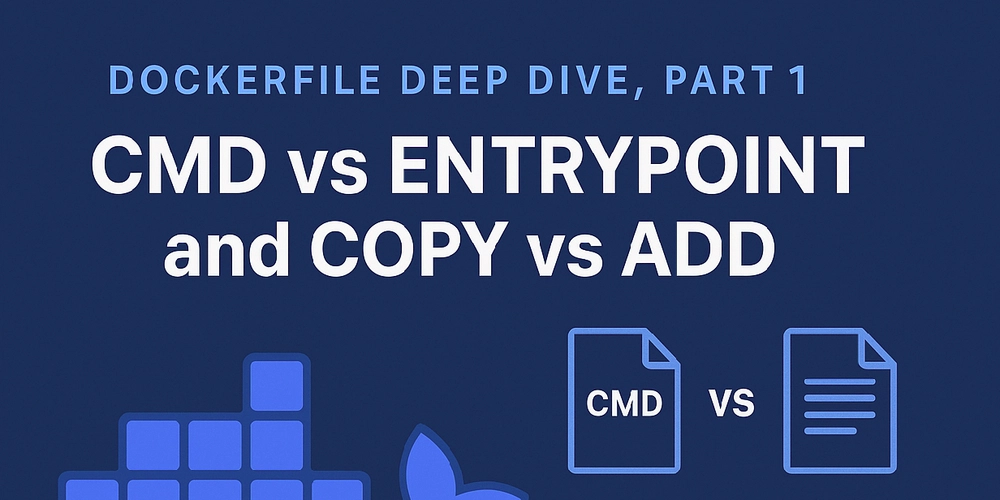Dockerfile Deep Dive, Part 1: CMD vs ENTRYPOINT and COPY vs ADD
Hello, DevOps Enthusiasts! Mastering Dockerfile instructions is essential for creating efficient, secure, and maintainable container images. In this post, we’ll break down two commonly misunderstood pairs of instructions—CMD vs ENTRYPOINT and COPY vs ADD—through a clear, side-by-side comparison. If you find it helpful, your support will help continue the series! ↻ CMD vs ENTRYPOINT in Dockerfile Both CMD and ENTRYPOINT define the command that runs when a container starts, but they behave differently. CMD CMD defines the default command or arguments that are executed when a container starts—only if no other command is provided at runtime. You can override CMD during container execution by passing a new command to docker run. FROM alpine CMD ["echo", "Hello Readers"] If you execute the container with docker run image-name, it will print: Hello Readers However, if you provide a different command when running the container, it overrides the CMD instruction entirely. For example: docker run image-name echo "Hello Devops Diaries Reader!" This will produce the output: Hello Devops Diaries Reader! This behavior makes CMD useful when you want to define a default command, but still allow users or scripts to run something else if needed. Tip: Use CMD when you want to specify default arguments or commands that can be easily changed by the user at runtime. For example, you might use CMD to set a default shell or script to execute. ENTRYPOINT The ENTRYPOINT instruction defines a command that always executes when the container starts. Unlike CMD, it cannot be overridden by a command passed at runtime unless you explicitly use the --entrypoint flag. If a command is provided during container execution, it is appended to the ENTRYPOINT. FROM alpine ENTRYPOINT ["echo", "Hello Readers"] Output: Hello Readers If we try to override the command by using the same as CMD in the runtime command docker run image-name hello Output: Hello Readers hello In this case, the command gets appended to the ENTRYPOINT. Example with --entrypoint to override the ENTRYPOINT You can override the ENTRYPOINT at runtime using the --entrypoint flag. This allows you to change the command that is executed when the container starts. docker run --entrypoint echo myimage "Hello, Custom Command" In this case, instead of executing the default ENTRYPOINT (which is echo Hello Readers), it will execute echo Hello, Custom Command. ➕ COPY vs ADD in Dockerfile Both COPY and ADD move files into a Docker image — but behave differently. COPY – Clean and Predictable Use it for: Copying local files and folders from your build context. Syntax: COPY Why use it: Only handles local content No extraction or downloading Clear and secure Example: FROM python:3.9 WORKDIR /app COPY requirements.txt . RUN pip install -r requirements.txt COPY app.py . ADD – More Features, More Risk Use it for: Archives and remote URLs. Syntax: ADD Extra features: Extracts .tar, .gz, etc., automatically to the target folder. Downloads from URLs directly into the image. When you use ADD with archives like .tar or .gz, it will automatically extract the contents to the specified target folder. This behavior can save you a step, but it also introduces complexity if you're not expecting it. Examples: Extract an archive: ADD app.tar.gz . In this example, the contents of app.tar.gz will be automatically extracted into the current working directory (.). If you specify a folder, the contents will be extracted to that directory. Download from a URL: ADD https://example.com/file.txt /data/ This command downloads the file.txt from the URL and places it into the /data/ directory inside the Docker image. Best Practice Use COPY by default Use ADD only for extraction or remote URLs (prefer curl or wget instead) Originally posted in here If you found this article helpful, please share it with your DevOps colleagues. Feel free to reach out to me at mail@iamkishorekumar.in with any thoughts or questions. Let’s grow together!

Hello, DevOps Enthusiasts!
Mastering Dockerfile instructions is essential for creating efficient, secure, and maintainable container images. In this post, we’ll break down two commonly misunderstood pairs of instructions—CMD vs ENTRYPOINT and COPY vs ADD—through a clear, side-by-side comparison.
If you find it helpful, your support will help continue the series!
↻ CMD vs ENTRYPOINT in Dockerfile
Both CMD and ENTRYPOINT define the command that runs when a container starts, but they behave differently.
CMD
CMD defines the default command or arguments that are executed when a container starts—only if no other command is provided at runtime.
You can override CMD during container execution by passing a new command to docker run.
FROM alpine
CMD ["echo", "Hello Readers"]
If you execute the container with docker run image-name, it will print:
Hello Readers
However, if you provide a different command when running the container, it overrides the CMD instruction entirely.
For example:
docker run image-name echo "Hello Devops Diaries Reader!"
This will produce the output:
Hello Devops Diaries Reader!
This behavior makes CMD useful when you want to define a default command, but still allow users or scripts to run something else if needed.
Tip: Use CMD when you want to specify default arguments or commands that can be easily changed by the user at runtime. For example, you might use CMD to set a default shell or script to execute.
ENTRYPOINT
The ENTRYPOINT instruction defines a command that always executes when the container starts.
Unlike CMD, it cannot be overridden by a command passed at runtime unless you explicitly use the --entrypoint flag. If a command is provided during container execution, it is appended to the ENTRYPOINT.
FROM alpine
ENTRYPOINT ["echo", "Hello Readers"]
Output:
Hello Readers
If we try to override the command by using the same as CMD in the runtime command
docker run image-name hello
Output:
Hello Readers hello
In this case, the command gets appended to the ENTRYPOINT.
Example with --entrypoint to override the ENTRYPOINT
You can override the ENTRYPOINT at runtime using the --entrypoint flag. This allows you to change the command that is executed when the container starts.
docker run --entrypoint echo myimage "Hello, Custom Command"
In this case, instead of executing the default ENTRYPOINT (which is echo Hello Readers), it will execute echo Hello, Custom Command.
➕ COPY vs ADD in Dockerfile
Both COPY and ADD move files into a Docker image — but behave differently.
COPY – Clean and Predictable
Use it for: Copying local files and folders from your build context.
Syntax:
COPY
Why use it:
- Only handles local content
- No extraction or downloading
- Clear and secure
Example:
FROM python:3.9
WORKDIR /app
COPY requirements.txt .
RUN pip install -r requirements.txt
COPY app.py .
ADD – More Features, More Risk
Use it for: Archives and remote URLs.
Syntax:
ADD
Extra features:
- Extracts .tar, .gz, etc., automatically to the target folder.
- Downloads from URLs directly into the image.
When you use ADD with archives like .tar or .gz, it will automatically extract the contents to the specified target folder. This behavior can save you a step, but it also introduces complexity if you're not expecting it.
Examples:
Extract an archive:
ADD app.tar.gz .
In this example, the contents of app.tar.gz will be automatically extracted into the current working directory (.). If you specify a folder, the contents will be extracted to that directory.
Download from a URL:
ADD https://example.com/file.txt /data/
This command downloads the file.txt from the URL and places it into the /data/ directory inside the Docker image.
Best Practice
- Use
COPYby default - Use
ADDonly for extraction or remote URLs (prefer curl or wget instead)
Originally posted in here
If you found this article helpful, please share it with your DevOps colleagues. Feel free to reach out to me at mail@iamkishorekumar.in with any thoughts or questions. Let’s grow together!












































































































































































![[The AI Show Episode 142]: ChatGPT’s New Image Generator, Studio Ghibli Craze and Backlash, Gemini 2.5, OpenAI Academy, 4o Updates, Vibe Marketing & xAI Acquires X](https://www.marketingaiinstitute.com/hubfs/ep%20142%20cover.png)




























































































































![[DEALS] The Premium Learn to Code Certification Bundle (97% off) & Other Deals Up To 98% Off – Offers End Soon!](https://www.javacodegeeks.com/wp-content/uploads/2012/12/jcg-logo.jpg)

![From drop-out to software architect with Jason Lengstorf [Podcast #167]](https://cdn.hashnode.com/res/hashnode/image/upload/v1743796461357/f3d19cd7-e6f5-4d7c-8bfc-eb974bc8da68.png?#)








































































































.png?#)


































_Christophe_Coat_Alamy.jpg?#)


.webp?#)





































































































![Apple Considers Delaying Smart Home Hub Until 2026 [Gurman]](https://www.iclarified.com/images/news/96946/96946/96946-640.jpg)
![iPhone 17 Pro Won't Feature Two-Toned Back [Gurman]](https://www.iclarified.com/images/news/96944/96944/96944-640.jpg)
![Tariffs Threaten Apple's $999 iPhone Price Point in the U.S. [Gurman]](https://www.iclarified.com/images/news/96943/96943/96943-640.jpg)




































































































































